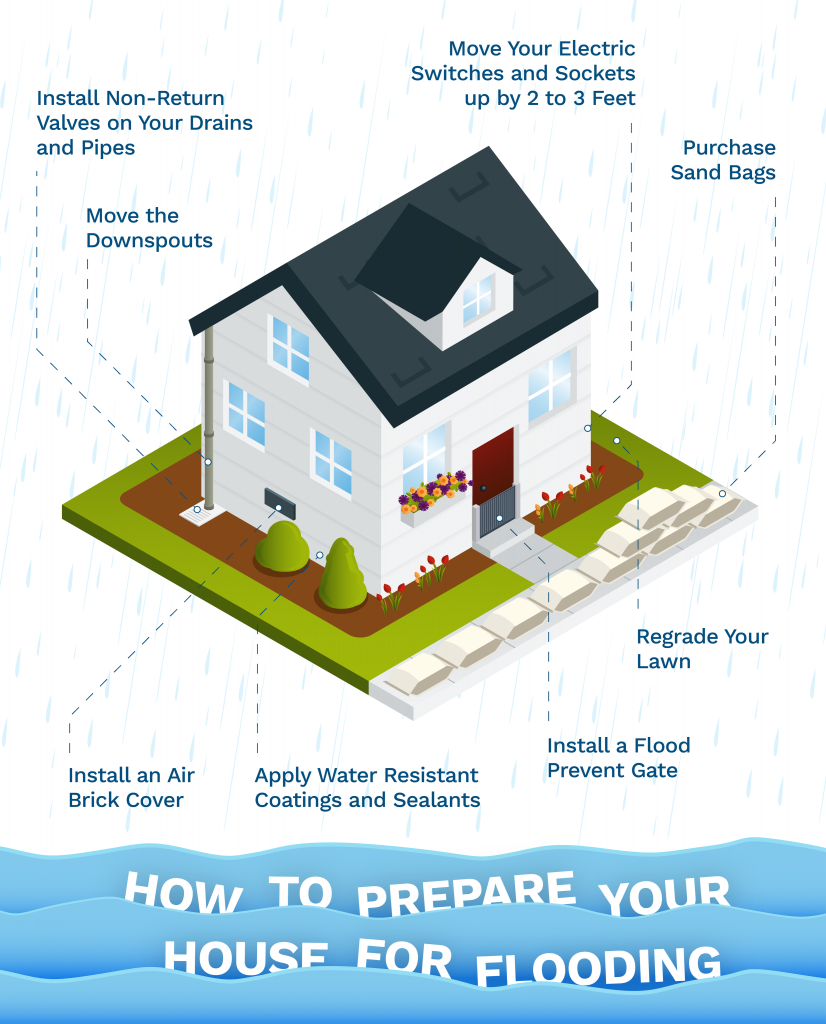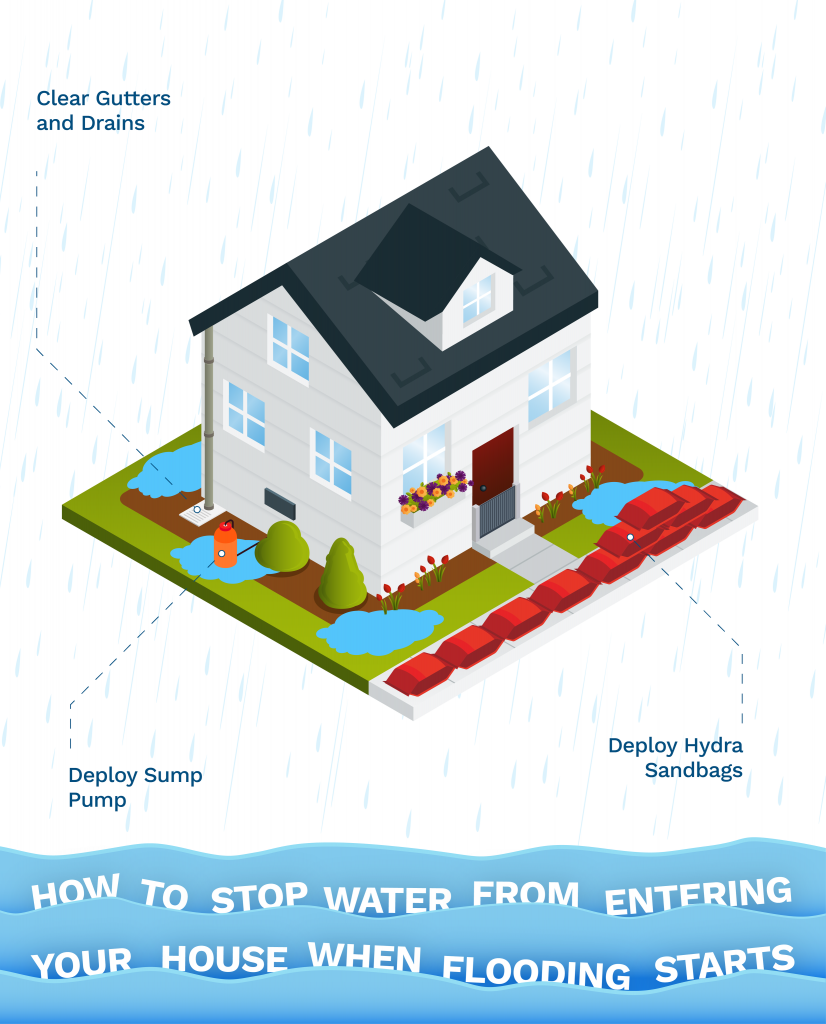How to Keep Flood Water Out of Your House (Expert Guide)
This is the complete guide to keeping flood water out of your house.
It covers:
- How to prepare your house for flooding
- How to stop water from entering your house when flooding starts
- How much does it cost to flood proof a home
- New tools to help you prevent flood water from entering your home
So, if you want to give yourself some control when the water starts to flow, you’ll love this guide.
Let’s get started.
How to Prepare Your House for Flooding
If you’re serious about flood proofing your home, then you probably need to face the fact that you’re going to have to spend a little money (not a lot, a little).
Why?
Well, flood proofing your home prior to water levels rising is vital. Preventative measures, once the flood waters start, can only do so much.
Saying that, look at the list of solutions below. Start by implementing the free, basic maintenance first. Then, assess the situation and try the next solution.
Move the Downspouts
If the gutters from the roof of your home run towards a drain that is likely to flood and then pool during heavy rain, then you will want to get them moved or redirected as soon as possible. Start by assessing the land gradient that your house lays on, then direct the gutters to the drain following the downwards direction. This will allow water to run away from home naturally.
Cost: DIY (Free) or Hire a Local Handyman for a Day
Install an Air Brick Cover
Air bricks are the vents on the side of your house that let air circulate in and out of your home. Buy an air brick cover that will seal the vent when there is a flood warning. You will need to remove the cover when the warning is over as the vent helps prevent mould or condensation accumulating in your home.
Cost: DIY (£15)
Apply Water Resistant Coatings and Sealants
Purchase a water-repellent sealant and then apply to your walls, doors and windows. This will act as a flood barrier, preventing water from entering your home through cracks in the brickwork or seeping through windows.
Cost: DIY (£49.99) or a Hire a Local Handyman for a Day
Install Non-Return Valves on Your Drains and Pipes
Non-return valves are small components installed on your pipework that ensure water can only flow one way. Installing them on pipes and drains will ensure water can pass through pipes, but can not flow back up the pipes to a toilet or sink. This can often happen in flooding when the drains are clogged and water starts to rise.
Cost: £50 for the component, plus £200 installation fee via a local plumber
Install a Flood Defence Gate
If you’re lucky enough to have a gate at the bottom of your driveway, you can install a flood defence gate that replaces your usual gate and seals off your whole property from incoming floodwaters. Of course, how useful this will be will depend entirely on your overall house borders and the gradient of your land.
Cost: £200 to £300 plus a £50 installation fee
Hire a Landscaper to Regrade Your Garden
This is one of the more expensive floodproofing renovations, but it will also offer you the most effective flood protection. Hire a landscaper gardener to regrade your garden so the water runs away from your home. You will need to be careful to ensure the water doesn’t run off into a nearby property, as this could incur damages that you will need to pay. Work with your landscaper to find the right solution.
Cost: £1000 plus
Move Your Electric Switches and Sockets up by 2 to 3 Feet
While the renovations listed above have been with the aim of preventing flood water from entering your home, you should also have renovations in place to prevent flood damage. One of the most important is protecting your electrics. Have an electrician move all outlets, switches and sockets up by about 2 to 3 feet. This will prevent significant electrical damage.
Raise Your Household Appliances
Protect your internal appliances by raising them two to three feet above the flood level. Raise all of the following appliances with a simple (but stylish) plinth:
- Washing Machines
- Dryers
- Generators
- TV
- Fridge Freezer
- Air Conditioners
You should also have an idea of where to store other key electrical items such as a microwave, radios and game consoles or how to steal smaller electronic items such as mobile phones, chargers and remote controls. This particularly key when there is a severe home flood risk and you have little time to prevent water from entering your home.
Cost: DIY (Free)
Purchase a Range of Sand Bags
Do not wait for the council to supply you with sand bags. Purchase your own, store them in the garage and have them ready to go when the water starts flowing. It’s called emergency management, and when it comes to protecting your own home, do not depend upon someone else coming to your rescue.
Cost: £22.95 each
Purchase Flood Insurance
There’s only so much you can do to protect your home from flood damage. Most of the suggestions listed above will protect you from minor floods, but severe floods could leave you with hundreds of thousands in damages, especially if there is structural damage to your home. Do not leave insurance to chance. Even forgetting to seal a door frame with sealant could cost you thousands. Play it safe, get insurance.
Cost: Depends on your personal circumstances
How to Stop Water From Entering Your House When Flooding Starts
The flooding has started, the water is pooling outside your home, you have limited time before it breaches your defences - what do you do?
The following:
Clear Gutters and Drains
Get outside and clear gutters and drains of any leaves, waste or other debris. Water needs to flow freely away from home and a blocked drain or gutter will allow water to quickly pool and flood.
Deploy Hydra Snake Sandbags
If the flooding has already started, then you need to act quickly. Unfortunately, heavy 15 to 20 kilo sandbags are not practical when the flooding has already started. That’s why we recommend stocking up on Hydra Snake Sandbags. These are less than 10% of the weight of traditional sandbags and only increase in weight when activated by water.
Start Up the Sump Pump
The final (but most key) line of defence is a sump pump. This is a type of pump that can be submerged in water and will pump it up and away from your home. They’re also fairly cheap, especially when you compare it to the potential damage caused to your home by flood water. Invest and defend your home.
New Tools to Help You Prevent Flood Water From Entering Your Home
Unfortunately, with sea levels rising, British weather becoming (even more so) unpredictable and new houses built of flood plains, you are no longer able to defend your home with just a mop and bucket.
Here are the tools you need to protect your home:
Water Repellent Sealant
You need a clear, high-performance waterproof treatment for exterior porous surfaces. This will help you repel water on wood, brick, concrete, paving, asbestos and cement. It’s a very versatile product that can even be used on garden brick walls to help protect your home. A great investment that will stop low-level water seeping into your home.
Search prices on Water Repellent Sealant here
Hydra Snake Sandbags
Sandbags are an absolute must. Unfortunately, regular sandbags are super heavy and can be a real pain to have lying around your home. That’s why we recommend Hydra Snake Sandbags. They only weigh 0.5kg when unactivated and will expand to 15kg once activated with water. That makes them super easy to deploy and super effective at defending your home from floodwaters. The only downside is that they are, as you can imagine, a one-use product.
Search prices on Hydra Snake Sandbags here.
Submersible Pump
The sump pump is another absolute must. In severe flooding, the water will breach your defences, no matter how hard you try to flood-proof your home. That’s why having a submersible pump to hand can be really handy when the water starts to pool outside your home. You should also practice using it, just so you know how to handle the kit when under pressure.
Search prices on Submersible Pumps here.
Flood Divert Gate
Flood diversions can come in all different shapes and sizes. You can get them for doors, windows and fences. However, we think the most practical is a flood divert gate. This looks the most natural and also allows you to keep water off your whole property, not just your house. You could also get a flood divert door installed, if you felt the extra protection was necessary.
Search prices on Flood Diversions here.
Free Advice
If you’re struggling for advice regarding protecting your home from flooding, ring our dedicated experts on 0800 112 3134 or 0333 577 3134. We’re open Monday to Friday 07:00 - 17:30 and Saturday 08:30 - 12:30.



